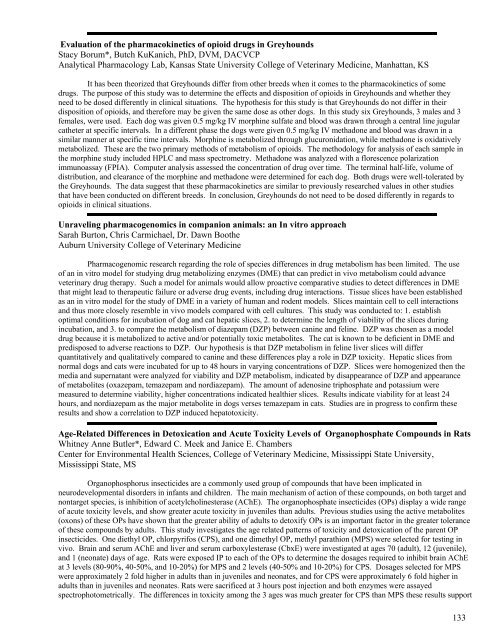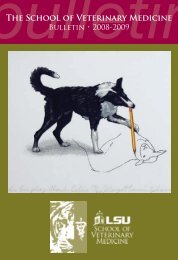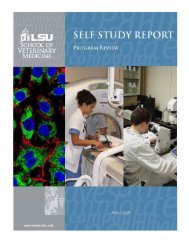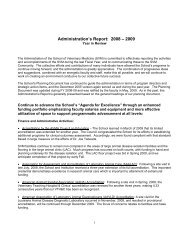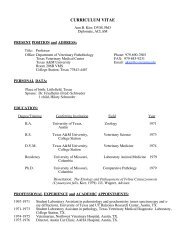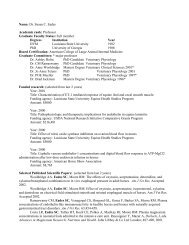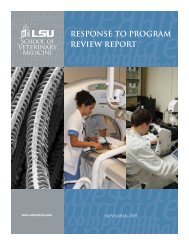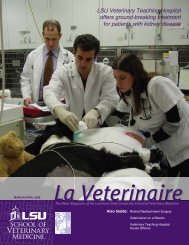undifferentiated catecholaminergic cell line (CAD) that has been shown previously to differentiate upon treatment withcAMP elevating agents. First we developed a quantitative assay to measure neurite growth. We transfected CAD cells witha lentiviral-GFP construct to visualize green cells within a confluent culture <strong>of</strong> non-transfected cells. Second, we plan to usegain and loss <strong>of</strong> function approaches to assay the effect <strong>of</strong> different proteins <strong>of</strong> the hypothesized cascade on the neuronalphenotype. We are currently developing siRNAs (small interfering RNAs) to silence ARP2/3 and WAVE proteins and planto transfect CAD cells with wild type and mutant Arabidopsis Rac-like genes. The results <strong>of</strong> this study will provide somepreliminary data regarding the signaling cascade that controls neuronal morphogenesis. It is an illustration <strong>of</strong> the power <strong>of</strong>applying knowledge from several distant biological fields. Here we show how an understanding <strong>of</strong> plant genetic systems canbe applied to complex mammalian neuron cell function.Comparative Fibrinogen Determinations in HorsesNikki Boehman*, Dr. Elizabeth WellesPathobiology Department, College <strong>of</strong> <strong>Veterinary</strong> <strong>Medicine</strong>, Auburn University, ALIntroduction: This study compared 3 different methods <strong>of</strong> fibrinogen concentration determination in horse bloodsamples. Fibrinogen is cleaved by thrombin to fibrin in the coagulation cascade enabling a clot to form and is an acute phaseprotein with increased production by the liver during inflammation. Horses were used because CBC values do not reflectinflammation as readily as in cats/dogs. Forty-seven horses were used, 20 healthy and 27 patients with inflammatorydiseases including peritonitis, pneumonia and snake bites.Methods: Fibrinogen concentration was determined by 3 methods (refractometer was used to measureplasma/serum protein): 1) EDTA plasma protein – serum protein (P-S), 2) EDTA plasma protein – EDTA plasma proteinafter heat precipitation (P-Php), and 3) functional fibrinogen derived from thrombin time via a mechanical clot detectioninstrument (fibr/TT). Fibrinogen also was determined by methods 1 and 2 using improperly filled EDTA tubes (P1/2).Results: Results <strong>of</strong> properly filled P-S vs. P-Php had 78% disagreement. When fibrinogen was increased, 15%disagreed P-S vs. P-Php, 22% disagreed P-S vs. fibr/TT, and 22% disagreed P-Php vs. fibr/TT. Improperly filled tube resultshad 96% disagreement P1/2-S vs. P1/2-P1/2hp; 52% disagreement P-S vs. P1/2 – S; and 67% disagreement P-Php vs. P1/2-P1/2hp. When fibrinogen was increased, 26% disagreed P1/2-S vs. P1/2-P1/2hp, 11% disagreed P-S vs. P1/2 –S, 15%disagreed P-Php vs. P1/2-P1/2hp, 30% disagreed P-S vs. P1/2-P1/2hp, 26% disagreed P-Php vs. P1/2-S, 26% disagreed P1/2-S vs. Fibr/TT and 30% disagreed P1/2-P1/2hp vs. fibr/TT. 11% <strong>of</strong> patients with inflammatory disorders had acuteinflammatory leukograms, 85% had increased fibrinogen by P-S, 70% by P-Php, and 70% by fibr/TT.Conclusions: Underfilled EDTA tubes resulted in artifactually high protein and fibrinogen concentrations. Themost sensitive test for measuring fibrinogen concentration is P-S based on collected data.Radiographic Evaluation <strong>of</strong> Perching Joint Angles in Avian SpeciesGlen Bonin, Susanne K. Lauer, Thomas N. Tully, Jr., Javier Nevarez, David Sanchez-Migallon Guzman, LorrieGaschen, Giselle HosgoodDepartment <strong>of</strong> <strong>Veterinary</strong> Clinical Sciences, <strong>School</strong> <strong>of</strong> <strong>Veterinary</strong> <strong>Medicine</strong>, <strong>Louisiana</strong> <strong>State</strong> University, BatonRouge, LA 70803Joints are immobilized for external coaptation, arthrodesis, and transarticular external skeletal fixation.Immobilization <strong>of</strong> the compromised joints in a physiologic perching angle is important to prevent pododermatitis in birdssecondary to weight-bearing on a single limb while perching. Normal joint angles have been described in dogs and cats,however, this knowledge cannot be transferred to the avian species due to significant differences in anatomy, biomechanicsand gait. The purpose <strong>of</strong> this study is to compare normal perching joint angles in four avian species. Forty birds, withoutprevious history <strong>of</strong> pelvic orthopedic injuries and no orthopedic abnormalities evident upon physical examination, wereenrolled in this study: ten Hispaniolan Amazons (Amazona ventalis), Barred Owls (Strix varia), ducks (Anas platyrhynchosplatyrhynchos), and Cockatiels (Nymphicus hollandicus). Each bird was positioned on a perching stick within a box. After anacclimatization period, standardized lateral, horizontal-beam radiographs were performed <strong>of</strong> both pelvic limbs. Three viewswith the pelvic limbs in symmetric (sym) and three views with the limbs in asymmetric (asym) perching positions were usedfor radiographic measurements <strong>of</strong> the hip (H), stifle (S), and intertarsal (IT) joint angles. The joint angles were measuredindependently by three different observers for the caudal (only for asymmetric position) and cranial (asymmetric andsymmetric positions) limbs based on predetermined anatomic landmarks using digital imaging s<strong>of</strong>tware (VetPACS, Version3.5.10, Carlsbad, Ca, USA). Preliminary results on the Cockatiels have been obtained by two <strong>of</strong> the three observers. Themean body weight <strong>of</strong> the Cockatiels was 86.7 g ± 1.3 g. All Cockatiels had a BCS <strong>of</strong> 3 to 3.5. The Cockatiels had mean hipjoint angles <strong>of</strong> 42.9 ○ ± 3.1 ○ (sym, cranial), 41.6 ○ ± 1.9 ○ (asym, cranial), and 35.3 ○ ± 1.1 ○ (asym, caudal). The mean stifleangles were 58.4 ○ ± 4.3 ○ (sym, cranial), 47.0 ○ ± 1.3 ○ (asym, cranial), and 52.1 ○ ± 2.1 ○ (asym, caudal). The mean intertarsalangles were 61.3 ○ ± 4.2 ○ (sym, cranial), 55.6 ○ ± 1.7 ○ (asym, cranial), and 64.6 ○ ± 1.1 ○ (asym, caudal). Final results <strong>of</strong> thisstudy will provide information on intra-species, inter-species, intra-user and inter-user variation <strong>of</strong> joint angle measurementsfor four avian species.132
Evaluation <strong>of</strong> the pharmacokinetics <strong>of</strong> opioid drugs in GreyhoundsStacy Borum*, Butch KuKanich, PhD, DVM, DACVCPAnalytical Pharmacology Lab, Kansas <strong>State</strong> University College <strong>of</strong> <strong>Veterinary</strong> <strong>Medicine</strong>, Manhattan, KSIt has been theorized that Greyhounds differ from other breeds when it comes to the pharmacokinetics <strong>of</strong> somedrugs. The purpose <strong>of</strong> this study was to determine the effects and disposition <strong>of</strong> opioids in Greyhounds and whether theyneed to be dosed differently in clinical situations. The hypothesis for this study is that Greyhounds do not differ in theirdisposition <strong>of</strong> opioids, and therefore may be given the same dose as other dogs. In this study six Greyhounds, 3 males and 3females, were used. Each dog was given 0.5 mg/kg IV morphine sulfate and blood was drawn through a central line jugularcatheter at specific intervals. In a different phase the dogs were given 0.5 mg/kg IV methadone and blood was drawn in asimilar manner at specific time intervals. Morphine is metabolized through glucuronidation, while methadone is oxidativelymetabolized. These are the two primary methods <strong>of</strong> metabolism <strong>of</strong> opioids. The methodology for analysis <strong>of</strong> each sample inthe morphine study included HPLC and mass spectrometry. Methadone was analyzed with a florescence polarizationimmunoassay (FPIA). Computer analysis assessed the concentration <strong>of</strong> drug over time. The terminal half-life, volume <strong>of</strong>distribution, and clearance <strong>of</strong> the morphine and methadone were determined for each dog. Both drugs were well-tolerated bythe Greyhounds. The data suggest that these pharmacokinetics are similar to previously researched values in other studiesthat have been conducted on different breeds. In conclusion, Greyhounds do not need to be dosed differently in regards toopioids in clinical situations.Unraveling pharmacogenomics in companion animals: an In vitro approachSarah Burton, Chris Carmichael, Dr. Dawn BootheAuburn University College <strong>of</strong> <strong>Veterinary</strong> <strong>Medicine</strong>Pharmacogenomic research regarding the role <strong>of</strong> species differences in drug metabolism has been limited. The use<strong>of</strong> an in vitro model for studying drug metabolizing enzymes (DME) that can predict in vivo metabolism could advanceveterinary drug therapy. Such a model for animals would allow proactive comparative studies to detect differences in DMEthat might lead to therapeutic failure or adverse drug events, including drug interactions. Tissue slices have been establishedas an in vitro model for the study <strong>of</strong> DME in a variety <strong>of</strong> human and rodent models. Slices maintain cell to cell interactionsand thus more closely resemble in vivo models compared with cell cultures. This study was conducted to: 1. establishoptimal conditions for incubation <strong>of</strong> dog and cat hepatic slices, 2. to determine the length <strong>of</strong> viability <strong>of</strong> the slices duringincubation, and 3. to compare the metabolism <strong>of</strong> diazepam (DZP) between canine and feline. DZP was chosen as a modeldrug because it is metabolized to active and/or potentially toxic metabolites. The cat is known to be deficient in DME andpredisposed to adverse reactions to DZP. Our hypothesis is that DZP metabolism in feline liver slices will differquantitatively and qualitatively compared to canine and these differences play a role in DZP toxicity. Hepatic slices fromnormal dogs and cats were incubated for up to 48 hours in varying concentrations <strong>of</strong> DZP. Slices were homogenized then themedia and supernatant were analyzed for viability and DZP metabolism, indicated by disappearance <strong>of</strong> DZP and appearance<strong>of</strong> metabolites (oxazepam, temazepam and nordiazepam). The amount <strong>of</strong> adenosine triphosphate and potassium weremeasured to determine viability, higher concentrations indicated healthier slices. Results indicate viability for at least 24hours, and nordiazepam as the major metabolite in dogs verses temazepam in cats. Studies are in progress to confirm theseresults and show a correlation to DZP induced hepatotoxicity.Age-Related Differences in Detoxication and Acute Toxicity Levels <strong>of</strong> Organophosphate Compounds in RatsWhitney Anne Butler*, Edward C. Meek and Janice E. ChambersCenter for Environmental Health Sciences, College <strong>of</strong> <strong>Veterinary</strong> <strong>Medicine</strong>, Mississippi <strong>State</strong> University,Mississippi <strong>State</strong>, MSOrganophosphorus insecticides are a commonly used group <strong>of</strong> compounds that have been implicated inneurodevelopmental disorders in infants and children. The main mechanism <strong>of</strong> action <strong>of</strong> these compounds, on both target andnontarget species, is inhibition <strong>of</strong> acetylcholinesterase (AChE). The organophosphate insecticides (OPs) display a wide range<strong>of</strong> acute toxicity levels, and show greater acute toxicity in juveniles than adults. Previous studies using the active metabolites(oxons) <strong>of</strong> these OPs have shown that the greater ability <strong>of</strong> adults to detoxify OPs is an important factor in the greater tolerance<strong>of</strong> these compounds by adults. This study investigates the age related patterns <strong>of</strong> toxicity and detoxication <strong>of</strong> the parent OPinsecticides. One diethyl OP, chlorpyrifos (CPS), and one dimethyl OP, methyl parathion (MPS) were selected for testing invivo. Brain and serum AChE and liver and serum carboxylesterase (CbxE) were investigated at ages 70 (adult), 12 (juvenile),and 1 (neonate) days <strong>of</strong> age. Rats were exposed IP to each <strong>of</strong> the OPs to determine the dosages required to inhibit brain AChEat 3 levels (80-90%, 40-50%, and 10-20%) for MPS and 2 levels (40-50% and 10-20%) for CPS. Dosages selected for MPSwere approximately 2 fold higher in adults than in juveniles and neonates, and for CPS were approximately 6 fold higher inadults than in juveniles and neonates. Rats were sacrificed at 3 hours post injection and both enzymes were assayedspectrophotometrically. The differences in toxicity among the 3 ages was much greater for CPS than MPS these results support133
- Page 1 and 2:
2006 MERCK/MERIALNATIONAL VETERINAR
- Page 6 and 7:
3:00-3:30 pm BreakNovel therapy for
- Page 8 and 9:
KEYNOTE SPEAKERRonald Veazey, D.V.M
- Page 10 and 11:
Mini Symposium II:Fish Research: A
- Page 12 and 13:
David G. Baker, D.V.M., M.S., Ph.D.
- Page 14 and 15:
Konstantin G. Kousoulas, Ph.D.Profe
- Page 16 and 17:
Joseph Francis, B.V.Sc., M.V.Sc., P
- Page 18 and 19:
dogs with cancer, the potential rol
- Page 20 and 21:
2006 MERCK/MERIALVETERINARY SCHOLAR
- Page 22 and 23:
YOUNG INVESTIGATOR AWARD HONORABLE
- Page 24 and 25:
Mammary epithelial-specific deletio
- Page 26 and 27:
2006 MERCK/MERIALVETERINARY SCHOLAR
- Page 28:
Variation in Q-Tract Length of the
- Page 34:
Novel therapy for humoral hypercalc
- Page 38:
ALTERNATE:Micron-scale membrane sub
- Page 42 and 43:
ABSTRACT TITLES LISTED BY CATEGORY
- Page 44 and 45:
19. A pilot study of cigarette smok
- Page 46 and 47:
36. Development of a murine in vitr
- Page 48 and 49:
ABSTRACT TITLES LISTED BY CATEGORY
- Page 50 and 51:
71. Identification and characteriza
- Page 52 and 53:
85. Age and Gender Influence Ventil
- Page 54 and 55:
ABSTRACT TITLES LISTED BY CATEGORY
- Page 56 and 57:
2006 MERCK/MERIALVETERINARY SCHOLAR
- Page 58 and 59:
10. Preliminary estimation of risk
- Page 60 and 61:
ABSTRACT TITLES LISTED BY CATEGORY
- Page 62 and 63:
47. Osteoprotegerin and Receptor Ac
- Page 64 and 65:
61. A Comparison of Interaction Pat
- Page 66 and 67:
ABSTRACT TITLES LISTED BY CATEGORY
- Page 68 and 69:
ABSTRACT TITLES LISTED BY CATEGORY
- Page 70 and 71:
ABSTRACT TITLES LISTED BY CATEGORY
- Page 72 and 73:
2006 MERCK/MERIALVETERINARY SCHOLAR
- Page 74 and 75:
used to label avian heterophils for
- Page 76 and 77:
obtained via analysis of time and d
- Page 78 and 79:
0.71mg/dL; p=0.001). Values for hem
- Page 80 and 81:
mass and fecundity in prespawning w
- Page 82 and 83: Equine Hoof Laminae Tissue Collecti
- Page 84 and 85: Aspiration Pneumonia in DogsDavid A
- Page 86 and 87: Distortion Product Otoacoustic Emis
- Page 88 and 89: tyrosine phosphorylation is measure
- Page 90 and 91: the gravid and non-gravid females t
- Page 92 and 93: egulatory function as its ortholog,
- Page 94 and 95: PATHOLOGY, TOXICOLOGY, AND ONCOLOGY
- Page 96 and 97: Markers of Oxidative Stress in plas
- Page 98 and 99: has been isolated from all samples
- Page 100 and 101: Matrix metalloproteinase secretion
- Page 102 and 103: Reproductive performance, neonatal
- Page 104 and 105: control to determine the efficiency
- Page 106 and 107: Enhancing the Quality and Reliabili
- Page 108 and 109: grade II MCTs into groups with good
- Page 110 and 111: Transcriptional Regulation of the I
- Page 112 and 113: MICROBIOLOGY AND IMMUNOLOGY (SESSIO
- Page 114 and 115: colonization of the mutant and 6 re
- Page 116 and 117: digestive tracts of these and other
- Page 118 and 119: 100 pfu BRSV. The results show that
- Page 120 and 121: Inhibition of Microneme Secretion i
- Page 122 and 123: Adherent bacilli were present in th
- Page 124 and 125: isolated to analyze cytokine gene e
- Page 126 and 127: purified, viral RNA was extracted a
- Page 128 and 129: The effects of co-engagement of TLR
- Page 130 and 131: Occurrence of Leptospira Vaccine Fa
- Page 134 and 135: the concept that the greater detoxi
- Page 136 and 137: quantitative PCR using gene targets
- Page 138 and 139: Rotenone Induced Dopamine Neuron De
- Page 140 and 141: decrease in serum cortisol, with a
- Page 142 and 143: and detrimental impacts on the brai
- Page 144 and 145: actions of cells prior to embryo de
- Page 146 and 147: Utilizing cDNA Subtraction to Exami
- Page 148 and 149: expression in unilaterally pregnant
- Page 150 and 151: Salmonella is increased. Poultry sa
- Page 152 and 153: exports. The estimated prevalence o
- Page 154 and 155: eeding grounds near Minnedosa, MB s
- Page 156 and 157: (PBMC) were isolated using commerci
- Page 158 and 159: 2006 MERCK/MERIALVETERINARY SCHOLAR
- Page 160 and 161: Trainees acquire in-depth knowledge
- Page 162 and 163: comparative pathology and/or resear
- Page 164 and 165: Department of Veterinary Bioscience
- Page 166 and 167: PhD, Director, Center for Comparati
- Page 168 and 169: 2006 MERCK/MERIALVETERINARY SCHOLAR
- Page 170 and 171: MICHIGAN STATEUNIVERSITYJames Crawf
- Page 172: UNIVERSITY OFPENNSYLVANIALindsay Th


